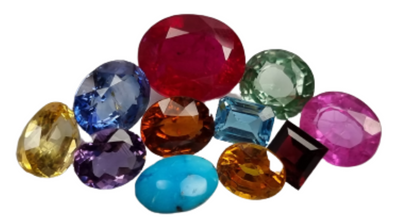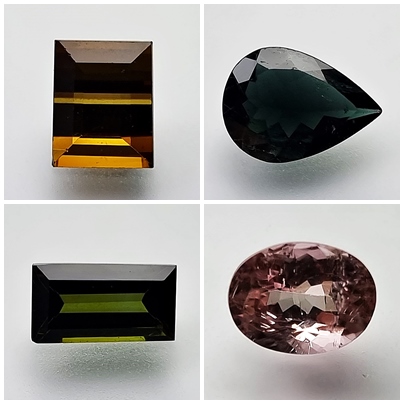-
About Tourmaline: Gemstone Information
Tourmaline is perhaps the ideal gemstone; sufficiently hard, very poor cleavage though somewhat brittle and a wide range of colors including parti-coloration which may be found along the length of the crystal or at right angles to that direction. Several important and/or colorful monographs have been devoted to tourmaline; in 1990 Der Tourmaline, by F. Benesch, published by UrachhausVerlag, Stuttgart, dazzled the gem book market with its great size and the magnificence of its color photographs. In 2003 Paul Rustemeyer’s Faszination Tourmaline (ISBN 3827414245) provided fine illustrations of tourmaline crystals. About Tourmaline from Maine, USA, is beautifully described by A.C. Hamlin in The Tourmaline (1873) and The History of Mount Mica of Maine, USA and Its Wonderful Deposits of Matchless Tourmalines (1895).
The tourmalines from the pegmatites of southern California are also minutely described, by Jahns and Wright, in Gem- and lithium-bearing pegmatites of the Pala district, San Diego County, California (California Division of Mines Special report 7-A, 1951). Finally there is Extra Lapis in English no. 3, Tourmaline, 2002 (ISBN 0971537127). The author is William Simmons.
The name tourmaline is conveniently used to describe a mineral group which, at the time of the publication of Fleischer’s Glossary of Mineral Species (the 8th edition, 1999; the most recent edition, 2004) did
not set out the groups with their constituent minerals although group membership was stated in the appropriate individual entries. The tourmaline group comprises 12 species, rosemanite having been added between 1999 and 2004. The tourmaline group members with important ornamental application are elbaite, dravite, uvite and liddicoatite.
Schrol, a black group member is sometimes fashioned or the crystals collected for their shiny black appearance. All tourmaline group members are borosilicates, crystallizing in the trigonal system as prismatic to acicular crystals striated lengthways and with characteristic rounded cross-sections. Hemimorphism is common. Tourmaline is pyroelectric and piezoelectric; the hardness is usually 7. Inclusions may be so placed that a cat’s-eye effect is possible though the eye is less sharp than its counterpart in chrysoberyl. The chemical complexity of minerals of the tourmaline group has so far ruled out serious attempts at synthesis. Though various names have been thought up over the years for the more strikingly colored tourmaline varieties, none of them has stuck and they are best found in Bayliss (Glossary of Obsolete Mineral Names, 2000).
The varying compositions of the tourmaline group minerals cause their properties to vary but in few if any cases should there be any confusion with other minerals. The gem species of the tourmaline group, already cited, have compositions well explained by William Simmons in Extra Lapis in English (see above). Working from a general structural formula for the group X Y3 Z6 [T6O18] [BO3]3 V3 W, where the letters represent specific crystallographic sites or positions within the tourmaline structure and showing which ions can occupy each site in the structural formula, Simmons, drawing on material from Hawthorne and Henry (European Journal of Mineralogy 11, 201–15, 1999), names the alkali species (X site Na) as elbaite, schorl, dravite, olenite, buergerite, chromdravite, povondraite and vanadiumdravite. Calcic tourmaline group species (X site Ca) are liddicoatite, uvite, feruvite. In rossmanite, foitite and magnesiofoitite the X site is vacant. For the sake of completeness I have included non-gem tourmaline group minerals above. Some of the species described are not diferentiated in Glossary of Mineral Species or in Anthony et al.
Following the same order, the Y3 site in elbaite contains Li 1.5 and Al 1.5; in schorl Fe2 or Fe3; in dravite Mg3; in olenite Al3; in buergerite Fe2 or Fe3; in chromdravite Mg3; in povondraite Fe2 or Fe3; in vanadiumdravite Mg3. In the calcic tourmalines, liddicoatite [Li2, Al]; in uvite Mg3; in feruvite Fe2 or Fe3; in rossmanite [Li, Al2]; in foitite [Fe2 or Fe3 Al]; in magnesiofoitite [Mg2, Al].
In the Z6 site elbaite, schorl, dravite, olenite, buergerite have Al6; chromdravite has Cr3 or Cr6; povondrite [Fe3 or 4, Mg2]; vanadiumdravite
[V3 or 6]; liddicoatite Al6; uvite [Al5, Mg]; feruvite [Al5, Mg]; rossmanite, foitite and magnesiofoitite Al6.
All species contain (BO3)3 and (OH)3. All alkali tourmalines contain (OH) except for buergerite and povondraite (of little or no ornamental significance) which contain (OH) and (O) respectively. Of the calcic tourmalines liddicoatite and uvite contain F, feruvite contains (OH). All the X-site vacant tourmalines contain (OH). It is possible that new species may be discovered. ExtraLapis English 3 gives a good account of tourmaline’s crystal structure and of the X-ray powder patterns with the seven highest intensity d-spacings with their peak intensities.
The tourmaline species with ornamental application can be separately described. Though elbaite, liddicoatite, uvite and dravite provide the majority of gemstones, brief notes on the other species can be given. Buergerite is found as transparent to translucent crystals, dark brown to yellow and would be sought as a mineral specimen. Good examples have been found in the Mexquitic area, San Luis Potosi, Mexico.
Chromdravite occurs as small acicular dark green crystals and has been found in Kareliya, Russia. Feruvite occurs only as grains. Foitite forms bluish black crystals which may reach 20 mm; one location is a pegmatite at the white Queen mine, Pala, California, USA. Magnesiofoitite crystals found in Yamanashi Prefecture, Japan, have not yet been described.
Olenite forms on the outer rim of acicular crystals with elbaite cores and has been found in the Kola Peninsula, Russia. Povondraite (originally defined as ferridravite) forms very small black crystals at a deposit in Bolivia. Rossmanite has been found in granite pegmatites as colorless to pale pink crystals; locations have been identified in Canada. The black tourmaline group mineral schorl occurs as long to short prismatic crystals and occurs in granite pegmatites and elsewhere. Vanadiumdravite forms very small dark green to yellow crystals at locations in the lake Baikal area of Russia.
From the point of view of the gemmologist it is not necessary to differentiate between the different tourmaline species – the existence of solid solution series between some tourmaline group members (between elbaite and dravite, for example) complicates differentiation. A review of the ornamental species relating specific gravity to color can be found in O’Donoghue, Gemstones, 1988 (ISBN 041227390X). Red to pink specimes are usually in the range 3.01–3.06; pale greenstones 3.05, brown stones 3.06, dark green 3.08–3.11, blue 3.05–3.11, yellow–orange 3.10. Black specimens are usually 3.11–3.12. Refractive index can be placed in the range 1.610–1.675 with an average birefringence of 0.018. Some faceted dark green tourmalines have been found to show up to six shadow-edges on the refractometer. The effect (the Kerez effect) can be removed by polishing (but it seems a pity!).
Pleochroism is strong and most commonly light and dark of the same color. The colors of elbaite are due to the presence of trace elements: Anthony et al. (1995) record 0.11% content of both FeO and MnO and 0.04 TiO2. Fe2 gives a green color and Fe3 blue; Mn2 gives pink and Mn3 red. Cu2 gives a fine blue in the Paraíba tourmalines mentioned below. Ti4 and Fe2 give yellow. Deeper reds are due to radiationinduced defects. A yellow elbaite reported from Madagascar was found to contain up to 8.9 wt% MnO. The location at Tsilaisina has given a largely unadopted name to tourmaline of this color.
Despite the range of colors no really useful absorption spectrum is found in tourmaline, though some red stones may show two narrow bands at 458 and 450 nm in the blue. In green tourmaline most of the red is absorbed down to around 640 nm with a narrow iron band showing at 497 nm in the blue. This band can also be found in green tourmaline.
Color zoning giving the familiar watermelon appearance with the red core and green rind is a feature of elbaite, the cause arising from more than one event, including a change of composition during growth. In the ordinary ray the pleochroic colors range from pink to pale green, pale to deep blue; in the extraordinary ray the crystals may show colorless to yellow, olive blue or purplish.
Liddicoatite is the calcium analogue of elbaite and is named after the late Richard T. Liddicoat, sometime President of the Gemological Institute of America. It occurs as prismatic crystals with pedions and can achieve considerable lengths. Striations are prominent and parallel to the vertical axis. The type locality where very fine crystals have been found in Anjanabonoina, Madagascar; it also occurs in the Sahatany valley in the same country. Examples have been found elsewhere, including Nigeria and Tanzania. Liddicoatite’s color may be pink, brown or colorless and multi-colored crystals are common. The colors may be zoned along the length of the crystal with sections cut at right angles to the length showing pronounced color zoning and triangular markings with some three-rayed stars. The pleochroism ranges from dark brown to pink, pale to deep blue in the ordinary ray; in the extraordinary ray light brown, colorless to yellow and olive green colors may be seen.
Dravite occurs as radiating crystals which may be short or long prismatic with or without striations. Equant forms do not usually show striations. Crystals may show a triangular cross-section with curved sides. The color may be brown to black, red, yellow, blue or green, colorless to white. The luster is greasy and the strong pleochroism shows brown to yellow in the ordinary ray and yellow to colorless in the extraordinary ray. Uvite crystals may be prismatic to equant, tabular or pyramidal and range up to 15 cm. The color may be brown, dark red, dark to light green, brown to black. Most crystals are translucent. The strong pleochroism is dark green and dark brown in the ordinary ray and olive green and light brown in the extraordinary ray. Uvite occurs most commonly in marbles and is found in Sri Lanka and at Franklin, New Jersey, USA.





